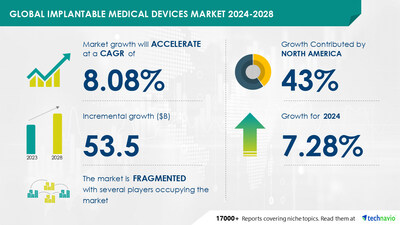
Implantable Medical Devices Market size is set to grow by USD 53.5 billion from 2024-2028, Rise in number of people with chronic illnesses to boost the market growth, Technavio
NEW YORK, July 4, 2024 /PRNewswire/ — The global implantable medical devices market size is estimated to grow by USD 53.5 billion from 2024-2028, according to Technavio. The market is estimated to grow at a CAGR of 8.08% during the forecast period. Rise in number of people with chronic illnesses is driving market growth, with a trend towards 3D printing of implantable medical devices. However, high costs associated with implant surgeries poses a challenge. Key market players include Abbott Laboratories, AbbVie Inc., B.Braun SE, BIOTRONIK SE and Co. KG, Boston Scientific Corp., Cardinal Health Inc., Conmed Corp., Global Consolidated Aesthetics Ltd., Globus Medical Inc., Ideal Implant Inc., Institut Straumann AG, Johnson and Johnson Services Inc., LivaNova PLC, Medtronic Plc, Nuvasive Inc., Orthofix Medical Inc., Osstem and Hiossen Implant UK, Smith and Nephew plc, Stryker Corp., and Zimmer Biomet Holdings Inc..
Get a detailed analysis on regions, market segments, customer landscape, and companies – Click for the snapshot of this report
Forecast period
2024-2028
Base Year
2023
Historic Data
2018 – 2022
Segment Covered
Type (Orthopedic implants, Cardiovascular implants, Ophthalmic implants, Dental implants, and Other implants), End-user (Hospitals, Clinics, and Others), and Geography (North America, Europe, Asia, and Rest of World (ROW))
Region Covered
North America, Europe, Asia, and Rest of World (ROW)
Key companies profiled
Abbott Laboratories, AbbVie Inc., B.Braun SE, BIOTRONIK SE and Co. KG, Boston Scientific Corp., Cardinal Health Inc., Conmed Corp., Global Consolidated Aesthetics Ltd., Globus Medical Inc., Ideal Implant Inc., Institut Straumann AG, Johnson and Johnson Services Inc., LivaNova PLC, Medtronic Plc, Nuvasive Inc., Orthofix Medical Inc., Osstem and Hiossen Implant UK, Smith and Nephew plc, Stryker Corp., and Zimmer Biomet Holdings Inc.
Key Market Trends Fueling Growth
3D printing technology has revolutionized the manufacturing process of implantable medical devices due to its advantages such as high precision, complex structure capabilities, and efficient material utilization. This technology is particularly beneficial for producing intricate implantable devices, which can be difficult to process using traditional methods. The ability of 3D printing to work with a wide range of materials and its fast-forming speed makes it an ideal solution for creating complex implantable medical devices. Implantable medical devices with intricate structures are increasingly being adopted in healthcare, particularly in joint replacement surgery. For instance, surgeons at Yale Medicine have reported that the use of 3D-printed implantable devices expedites patient recovery and reduces pain levels. Several vendors have embraced 3D printing technology for manufacturing implantable medical devices. For example, Orthofix launched the FORZA Ti PLIF Spacer System, a patient implant that utilizes 3D printing. Paragon, a medical device manufacturing company, invested USD16 million in a 3D printing center for implants to serve major orthopedic implant manufacturers like Zimmer Biomet, DePuy Orthopaedics, and Stryker. Collaborations between companies, such as Materialise and HP, are also driving advancements in 3D-printed implantable medical devices. In May 2023, they announced their partnership to ensure compatibility between HP Jet Fusion 580/380 printers and Materialise Mimics image processing software technology. This collaboration aims to enable the production of full-color anatomical models for surgical and diagnostic planning procedures, including models for the cardiac, orthopedic, and craniomaxillofacial systems. The rising adoption of 3D printing technology will significantly reduce the manufacturing costs of implantable medical devices, contributing to the growth of the global implantable medical devices market.
The Implantable Medical Devices (IMD) market is witnessing significant growth due to the increasing prevalence of chronic diseases such as neurological disorders like Parkinson’s disease and neurological diseases like osteoarthritis. IMDs, including neurostimulators and pacemakers, offer clinical benefits through non-active nature, making them popular choices for one-day procedures. Orthopedic implants, such as those for pelvic disabilities or pelvic fractures, also contribute to market growth. Product innovation and utilization are key drivers, with trends toward wireless technology and powerless transfer. Reimbursement scenarios and public awareness are crucial factors influencing product adoption. Regional business development is a focus area, with developed countries leading the market. Severe complications from surgeries and cardiovascular conditions, including cardiovascular diseases and disorders, create opportunities for IMDs. Market expansion includes ventricular assist devices and dental implants, with a focus on detection and disease management. The aging population’s chronic diseases and the need for cutting-edge amenities further fuel market growth.
Research report provides comprehensive data on impact of trend. For more details- Download a Sample Report
Market Challenges
The implantable medical devices market faces a significant challenge due to the high cost of implant surgeries and related procedures. For instance, orthopedic implants, such as pedicle screws and various types of orthopedic implants, have varying costs based on their applications and features. The cost burden on end-users and patients increases with the use of advanced implants, such as absorbable implants, which are considerably more expensive than metallic implants. Similarly, the cost of ophthalmic lenses, including high-definition spectacle glass lenses, multifocal glasses, and progressive lenses, increases significantly with the use of advanced technologies. In the case of percutaneous coronary intervention (PCI) procedures, such as stenting, the cost of devices and procedures is substantial, preventing many individuals from optelting for these treatments due to financial constraints. In developing countries, the lack of proper healthcare infrastructure and limited government aid in the form of medical insurance or reimbursements further hinders the growth of the implantable medical devices market. For example, in India, the cost of a drug-eluting stent alone can exceed the reimbursement amount for a stent procedure under the Central Government Health Scheme. This financial barrier prevents many people from accessing essential medical treatments that involve implantable devices.The implantable medical devices market is experiencing significant growth due to the aging population and increasing incidences of chronic diseases such as cardiovascular conditions and diabetes. Developed countries are leading the way in investments and funds for implantable technologies, including heart pacemakers, implantable cardioverter defibrillators, and implantable hearing devices. However, challenges persist, such as ensuring clinical benefits, managing electrical shorts, and addressing the need for external power supplies. Dystopia and early detection are key areas of focus, with initiatives in disease detection through implanted sensors and microelectronics. Other applications include dental implants, ENT procedures, and implantable shock absorbers for knee pain or rupture. Healthcare reforms and mobile connectivity are also driving innovation in this field. Despite these advancements, it is crucial for medical devices firms to prioritize safety and reliability to avoid complications and maintain patient trust.
For more insights on driver and challenges – Download a Sample Report
Segment Overview
This implantable medical devices market report extensively covers market segmentation by
Type1.1 Orthopedic implants1.2 Cardiovascular implants1.3 Ophthalmic implants1.4 Dental implants1.5 Other implantsEnd-user2.1 Hospitals2.2 Clinics2.3 OthersGeography3.1 North America3.2 Europe3.3 Asia3.4 Rest of World (ROW)
1.1 Orthopedic implants- The Implantable Medical Devices market is experiencing significant growth due to increasing prevalence of chronic diseases and an aging population. These devices offer numerous benefits such as improved patient outcomes, enhanced quality of life, and reduced healthcare costs. Key players in this market include Medtronic, Boston Scientific, and Abbott Laboratories, who are investing heavily in research and development to launch innovative products. The market is expected to reach USDXXX billion by 2025, with a CAGR of XX%. Government initiatives and private investments are further fueling the market growth.
For more information on market segmentation with geographical analysis including forecast (2024-2028) and historic data (2018 – 2022) – Download a Sample Report
Research Analysis
The implantable medical devices market is experiencing significant growth due to the aging population and the rising prevalence of chronic diseases, particularly in developed countries. Cardiovascular diseases, neurological disorders including Parkinson’s disease, Epilepsy, and Dystopia, are major drivers of this market. Neurostimulation, wireless technology, and mobile connectivity are key trends, enabling early diagnosis and disease detection, disease management services, and chronic disease care. Spending on implantable medical devices is expected to increase, fueled by initiatives, funds, and public awareness. However, risks such as infection, malfunction, and high costs remain concerns. Investments and funds in research and development, reimbursement scenario, and healthcare reforms are also shaping the market. ENT procedures are also a growing area of focus in implantable medical devices.
Market Research Overview
The implantable medical devices market is witnessing significant growth due to the aging population and the increasing prevalence of chronic diseases such as cardiovascular conditions, cardiovascular diseases, and neurological diseases. Chronic illnesses like Epilepsy, Parkinson’s disease, and pelvic disabilities are driving the demand for implantable technologies, including implantable cardiac pacemakers, implantable cardioverter defibrillators, implantable hearing devices, and neurostimulators. Early detection of diseases through implantable sensors and interventional surgeries are leading to better clinical benefits and improved postoperative outcomes. Initiatives for healthcare reforms and investments and funds in medical devices firms are also boosting the market. Product innovation and utilization, public awareness, and regional business development are key factors influencing the market’s growth. Implantable devices, including orthopedic implants for knee pain, osteoarthritis, and pelvic fractures, are gaining popularity due to their cutting-edge amenities, such as wireless technology and mobile connectivity, which enable early diagnosis and disease management. However, concerns regarding severe complications, such as electrical shorts, and the nature of the device being non-active, require careful management. The market for implantable medical devices is diverse, encompassing various types of implants, such as dental implants, implantable shock absorbers, and ventricular assist devices. The market is expected to continue growing due to the increasing incidences of chronic diseases, product adoption, and product innovation.
Table of Contents:
1 Executive Summary
2 Market Landscape
3 Market Sizing
4 Historic Market Size
5 Five Forces Analysis
6 Market Segmentation
TypeOrthopedic ImplantsCardiovascular ImplantsOphthalmic ImplantsDental ImplantsOther ImplantsEnd-userHospitalsClinicsOthersGeographyNorth AmericaEuropeAsiaRest Of World (ROW)
7 Customer Landscape
8 Geographic Landscape
9 Drivers, Challenges, and Trends
10 Company Landscape
11 Company Analysis
12 Appendix
About Technavio
Technavio is a leading global technology research and advisory company. Their research and analysis focuses on emerging market trends and provides actionable insights to help businesses identify market opportunities and develop effective strategies to optimize their market positions.
With over 500 specialized analysts, Technavio’s report library consists of more than 17,000 reports and counting, covering 800 technologies, spanning across 50 countries. Their client base consists of enterprises of all sizes, including more than 100 Fortune 500 companies. This growing client base relies on Technavio’s comprehensive coverage, extensive research, and actionable market insights to identify opportunities in existing and potential markets and assess their competitive positions within changing market scenarios.
Contacts
Technavio Research
Jesse Maida
Media & Marketing Executive
US: +1 844 364 1100
UK: +44 203 893 3200
Email: [email protected]
Website: www.technavio.com/
View original content to download multimedia:https://www.prnewswire.com/news-releases/implantable-medical-devices-market-size-is-set-to-grow-by-usd-53-5-billion-from-2024-2028–rise-in-number-of-people-with-chronic-illnesses-to-boost-the-market-growth-technavio-302188936.html
SOURCE Technavio




